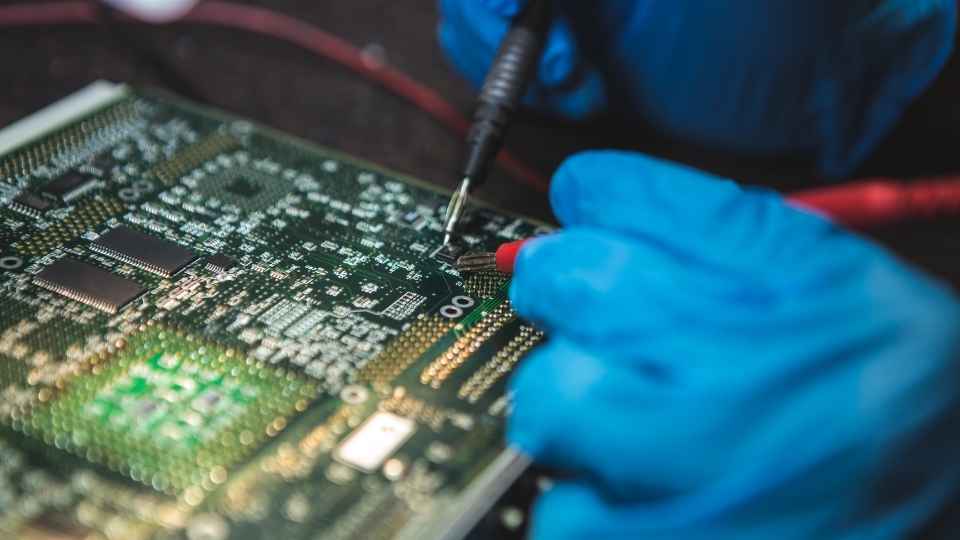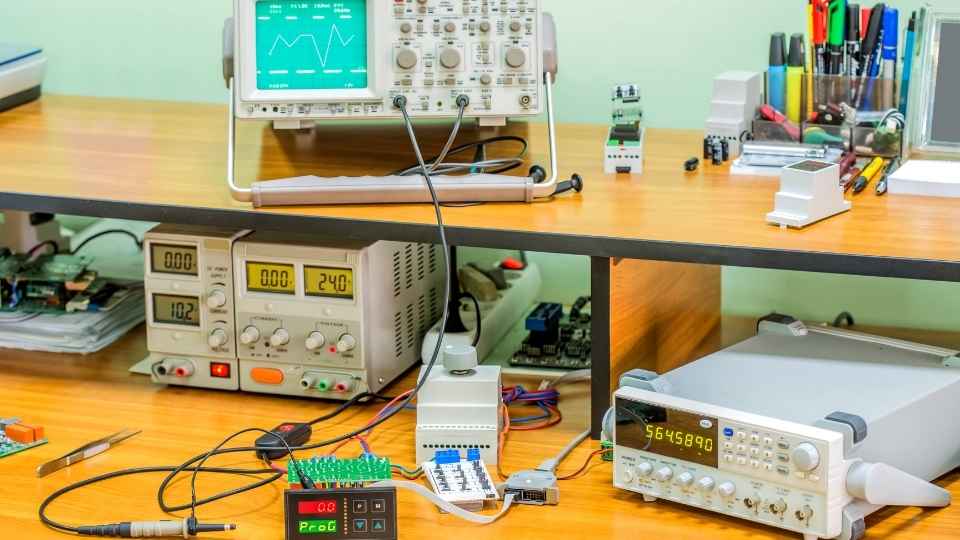
Imagine a tiny, powerful brain capable of storing and managing vast amounts of data. This is the world of microcontroller memory. From RAM to ROM, EEPROM to Flash Memory, these electronic marvels employ various types of memory to ensure seamless operation in countless applications.
In this article, we will dive into the intricate workings of microcontroller memory, exploring its different types and management techniques. Whether you're an engineer or just curious about the inner workings of technology, join us as we unravel the secrets behind how microcontrollers store and manage data with precision and efficiency.
Key Takeaways
- Microcontrollers use different types of memory, such as RAM, ROM, Flash memory, and EEPROM, to store and manage data.
- RAM is volatile memory used for temporary storage during program execution, while ROM is non-volatile memory that retains data even when power is turned off.
- Dynamic memory allocation and virtual memory management are memory management techniques used to optimize memory utilization and handle limited resources effectively.
- Different types of ROM, such as PROM, EPROM, and EEPROM, provide varying levels of flexibility and permanence for storing program code or firmware.
Types of Microcontroller Memory
There are several types of memory used in microcontrollers to store and manage data. These include Random Access Memory (RAM), Read-Only Memory (ROM), Flash memory, and Electrically Erasable Programmable Read-Only Memory (EEPROM).
RAM is a volatile type of memory that allows for fast read and write operations, but it loses its data when power is lost.
ROM, on the other hand, stores permanent data that cannot be modified or erased.
Flash memory is non-volatile and can be rewritten multiple times, making it suitable for storing program code.
EEPROM combines the benefits of both ROM and RAM by allowing for non-volatile storage that can be electrically erased and reprogrammed.

These different types of memory provide microcontrollers with the ability to store and manage data efficiently, giving users freedom in designing their applications.
RAM: Random Access Memory
Random Access Memory (RAM) is a type of computer memory that allows data to be read from and written to in any order, regardless of the physical location of the data.
It is volatile memory, meaning that its contents are lost when power is disconnected.
RAM plays a crucial role in a computer's performance, as it provides fast access to data for processing by the CPU.
RAM Vs ROM
RAM and ROM are two types of memory used in microcontrollers for storing and managing data.
RAM, or Random Access Memory, is a volatile type of memory that allows for quick read and write operations. It is commonly used for temporary storage of data during program execution.
On the other hand, ROM, or Read-Only Memory, is a non-volatile type of memory that retains its data even when power is turned off. It is typically used to store permanent data such as program instructions and system configurations.

While RAM provides flexibility in terms of read/write operations, ROM ensures the preservation of critical information. The choice between RAM and ROM depends on the specific requirements of the application at hand, with freedom to select the most suitable option depending on the desired functionality and performance needs.
Memory Management Techniques
One effective approach to efficiently utilize memory resources in microcontrollers is through the implementation of various memory management techniques.
These techniques allow for the allocation and deallocation of memory dynamically, ensuring that memory is used optimally and that there is no wastage.
One commonly used technique is called dynamic memory allocation, which allows for the creation and destruction of variables at runtime. This helps in managing limited memory resources effectively by allocating only as much memory as needed.
Another technique is virtual memory management, which enables a microcontroller to use more memory than it physically has by using secondary storage such as flash or hard drives. This provides greater flexibility in managing large amounts of data and ensures smooth execution of programs even with limited physical memory.
Overall, these techniques play a crucial role in enabling microcontrollers to efficiently store and manage data while maximizing their performance capabilities.
ROM: Read-Only Memory
ROM, or Read-Only Memory, is a type of computer memory that permanently stores data and instructions. Unlike RAM, ROM retains information even when the power is turned off, making it non-volatile.

There are different types of ROM such as Mask ROM, PROM, EPROM, and EEPROM, each with their own characteristics and uses in various applications.
ROM Vs RAM
The choice between ROM and RAM in microcontroller memory systems depends on the specific needs and requirements of the application.
ROM, or Read-Only Memory, is non-volatile memory that retains its contents even when power is turned off. It is commonly used to store permanent data such as firmware or program code.
On the other hand, RAM, or Random Access Memory, is volatile memory that loses its contents when power is disconnected. It provides temporary storage for data during runtime and allows for fast read and write access.
The decision to use ROM or RAM depends on factors such as the size of the required memory, the need for data persistence, and the speed of access required by the application.
Both ROM and RAM play crucial roles in microcontroller memory systems, offering flexibility and freedom in designing efficient solutions for various applications.
Types of ROM
Different types of ROM, such as PROM, EPROM, and EEPROM, offer varying levels of flexibility and permanence for storing program code or firmware in microcontroller memory systems.

Programmable Read-Only Memory (PROM) allows users to write data into the memory once. However, it cannot be erased or reprogrammed afterwards.
Erasable Programmable Read-Only Memory (EPROM) provides the ability to erase and reprogram the memory using ultraviolet light exposure. This offers more flexibility than PROM but requires a separate erasing process.
Electrically Erasable Programmable Read-Only Memory (EEPROM) takes flexibility further by allowing data to be erased and reprogrammed electronically without requiring any additional equipment. EEPROM can selectively erase specific bits of data while leaving other parts intact, providing greater freedom in modifying stored information.
These different types of ROM enable microcontrollers to store program code or firmware efficiently while offering options for data modification when necessary.
ROM Applications
Applications of ROM in various industries include storing firmware for embedded systems, preserving critical system data in medical devices, and ensuring the integrity of software programs in aerospace technology.
ROM, or Read-Only Memory, is a non-volatile memory type that permanently stores data and instructions. Its applications are diverse and essential for many industries. Here are five examples:
- Automotive industry: ROM is used to store vehicle control system firmware.
- Gaming industry: ROM stores game software and code that cannot be altered by users.
- Consumer electronics: ROM is utilized to store device firmware and operating systems.
- Security systems: ROM preserves critical data such as access codes and encryption keys.
- Telecommunication networks: ROM stores routing tables and network protocols.
These applications demonstrate the importance of ROM in various fields where permanent storage of critical information is necessary.

Transitioning into the subsequent section about EEPROM, let's explore another type of non-volatile memory that offers more flexibility in terms of erasing stored data.
EEPROM: Electrically Erasable Programmable Read-Only Memory
EEPROM, being a non-volatile memory technology, allows for the electric erasure and reprogramming of data. It is widely used in microcontrollers to store small amounts of critical information that needs to be retained even when power is removed.
EEPROM works by using electrical signals to erase and write data, making it ideal for applications where frequent updates or modifications are necessary. This type of memory offers the advantage of being able to selectively modify specific data without affecting other parts, providing flexibility and efficiency.
However, EEPROM has limited endurance compared to other types of memory due to the finite number of erase/write cycles it can withstand.
As we delve further into microcontroller memory technologies, let's now explore flash memory: a non-volatile storage solution known for its high density and fast access times.
Flash Memory: Non-Volatile Storage Solution
Flash memory is a popular choice for non-volatile storage due to its high density and fast access times. It provides a reliable and efficient solution for storing data in electronic devices, ranging from microcontrollers to smartphones.
Here are five key features of flash memory:

Non-volatility: Flash memory retains data even when the power is turned off, ensuring that information is not lost.
High density: Flash memory can store large amounts of data in a compact form factor, making it ideal for devices with limited space.
Fast access times: Flash memory allows for quick retrieval of stored information, enabling smooth and responsive user experiences.
Durability: Flash memory is resistant to mechanical shock and vibration, making it suitable for rugged environments.
Low power consumption: Flash memory consumes minimal power during read/write operations, contributing to longer battery life in portable devices.
These features make flash memory an excellent choice for applications where freedom from data loss and high performance are critical factors.
Memory Management Techniques
Efficient memory management techniques are crucial for optimizing the storage and retrieval of information in electronic devices.

Microcontrollers, being embedded systems with limited resources, require efficient memory management to ensure optimal performance and utilization of available memory.
One common technique used is dynamic memory allocation, where memory is allocated dynamically at runtime for variables and data structures as needed. This allows for flexible use of memory and prevents wastage of resources.
Additionally, microcontrollers often employ techniques like stack-based allocation, where temporary variables and function calls are managed on a stack to efficiently utilize the available memory.
Memory fragmentation is another challenge that needs to be addressed through techniques like garbage collection or defragmentation algorithms to optimize space utilization.
These memory management techniques play a vital role in ensuring smooth operation and maximum utilization of microcontroller memories while maintaining efficiency and performance.
Best Practices for Data Storage and Management
One important aspect to consider when it comes to optimizing storage and retrieval of information in electronic devices is the implementation of best practices for data storage and management. These practices ensure efficient utilization of memory resources, enhance data integrity, and improve overall system performance.
Here are five essential best practices for data storage and management:

Regular backup: Creating backups at regular intervals helps prevent data loss in case of hardware failures or accidental deletions.
Data encryption: Implementing encryption techniques ensures that sensitive information remains secure even if unauthorized access occurs.
Compression algorithms: Utilizing compression algorithms reduces the size of stored data, enabling more efficient use of memory space.
File organization: Structuring files in a logical manner enhances accessibility and simplifies search operations.
Garbage collection: Employing garbage collection mechanisms automatically reclaims unused memory, preventing memory leaks and improving efficiency.
Frequently Asked Questions
How Do Microcontrollers Store and Manage Data in Real-Time Applications?
Microcontrollers store and manage data in real-time applications by utilizing their internal memory. They employ various types of memory, such as Flash, SRAM, and EEPROM, to store program instructions, variables, and user data efficiently and reliably.
What Are the Factors That Affect the Lifespan and Reliability of Microcontroller Memory?
The lifespan and reliability of microcontroller memory are influenced by various factors. These include the quality of the memory cells, operating temperature, voltage fluctuations, and the frequency of read and write operations.

Can Microcontroller Memory Be Upgraded or Expanded?
Yes, microcontroller memory can be upgraded or expanded. This allows for increased storage capacity and improved performance. Upgrading or expanding the memory involves adding additional chips or modules to the existing microcontroller setup.
What Are the Common Challenges Faced in Managing Data Storage in Microcontrollers?
Managing data storage in microcontrollers presents several common challenges, including limited memory capacity, the need for efficient data organization and retrieval, and ensuring data integrity and security.
Are There Any Specific Techniques or Technologies Used for Secure Data Storage in Microcontrollers?
To ensure secure data storage in microcontrollers, specific techniques and technologies are employed. These include encryption algorithms, secure key storage mechanisms, hardware-based security features like tamper detection, and secure boot processes to prevent unauthorized access or manipulation of stored data.
 Basic Electronics ConceptsEssential ToolsCircuit Design BasicsMicrocontrollersDIY Electronics ProjectsRoboticsPrivacy PolicyTerms And Conditions
Basic Electronics ConceptsEssential ToolsCircuit Design BasicsMicrocontrollersDIY Electronics ProjectsRoboticsPrivacy PolicyTerms And Conditions
